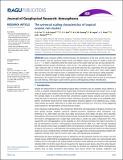The universal scaling characteristics of tropical oceanic rain clusters
Author(s)
Teo, C.-K.; Huynh, H.-N.; Koh, T.-Y.; Cheung, K. K. W.; Legras, B.; Chew, L. Y.; Norford, Leslie Keith; ... Show more Show less
DownloadPublished version (3.874Mb)
Alternative title
Scaling of Tropical Rain Clusters
Terms of use
Metadata
Show full item recordAbstract
Using multiyear satellite rainfall estimates, the distributions of the area, and the total rain rate of rain clusters over the equatorial Indian, Pacific, and Atlantic Oceans was found to exhibit a power law f[subscript s](s)~s[superscript -ζ[subscript s]], in which S represents either the cluster area or the cluster total rain rate and f[subscript s](s) denotes the probability density function of finding an event of size s. The scaling exponents ζS were estimated to be 1.66 ± 0.06 and 1.48 ± 0.13 for the cluster area and cluster total rain rate, respectively. The two exponents were further found to be related via the expected total rain rate given a cluster area. These results suggest that convection over the tropical oceans is organized into rain clusters with universal scaling properties. They are also related through a simple scaling relation consistent with classical self-organized critical phenomena. The results from this study suggest that mesoscale rain clusters tend to grow by increasing in size and intensity, while larger clusters tend to grow by self-organizing without intensification. Keywords: tropical rain clusters; self-organized criticality
Date issued
2017-05Department
Massachusetts Institute of Technology. Department of ArchitectureJournal
JGR Atmospheres
Publisher
American Geophysical Union (AGU)
Citation
Teo, C.-K. et al. "The universal scaling characteristics of tropical oceanic rain clusters." JGR Atmospheres 122 (June 2017): 5582-5599 © 2017 American Geophysical Union
Version: Final published version
ISSN
2169-897X